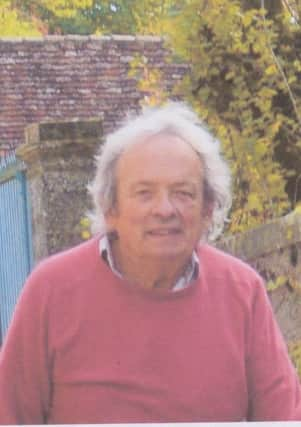Obituary: Alexander Cairns-Smith, scientist


The ideas of Edinburgh-educated Scottish scientist Alexander Graham Cairns-Smith about the origins of life and consciousness struck a chord with the popular imagination in the 1980s, and today are still being explored.
The most striking among his propositions, the “clay hypothesis”, has been the subject of television programmes, books, and lectures around the world. This is the idea that the workings of complex structures such as DNA – “the building-block of life”, of which the molecular make-up was discovered in 1953 – may have been preceded by similar processes in minerals such as clay. The way that tiny crystals in clay, an inorganic substance, continually break and re-form as “daughter” crystals, he suggested, may have prefigured genetic activity, and their patterns may have been taken over by more complex organic molecules – the beginnings of life.
Advertisement
Hide AdAdvertisement
Hide AdHis book Seven Clues to the Origin of Life (1985) caused controversy and inspired new thought. It has been translated into nine languages and sold more than 40,000 copies. In it, to suggest the sort of thinking needed for discovery, he put clues from Conan Doyle’s Sherlock Holmes stories at the top of each chapter. He wrote a number of other books, as well as publishing many papers, and in 1996 took his arguments further with Evolving the Mind: On the Nature of Matter and the Origin of Consciousness”.
Cairns-Smith’s ideas are taken up and enthusiastically discussed, with 11 pages devoted to them, by Richard Dawkins in his book The Blind Watchmaker (1986), and he is one of those from whose suggestions, Dawkins acknowledges in his preface, “I have benefited greatly.”
Known to friends and family as Graham, Cairns-Smith did his first degree, in chemistry, at Edinburgh University and completed his PhD there before transferring, in the 1950s, to an academic career at the University of Glasgow. He would later appear on the BBC Horizon programme, and be one of a number of eminent speakers at the annual meeting of the British Association in 1983, introduced as Dr A.G. Cairns-Smith of inorganic- origins-of-life fame.
Glasgow University made him an Honorary Senior Research Fellow, and he was a Fellow of the Royal Society of Edinburgh.
A handsome man with a mop of dark curly hair and a penchant for wearing bright shirts, Cairns-Smith, the son of a lawyer from Kilmarnock, was for the first 20 years of his university career also a noted artist, giving one-man exhibitions of his landscape and abstract works in watercolour and oils. At school as a boarder at Fettes College in Edinburgh he had been taught art by Denis Peploe, son of SJ Peploe; by the portrait painter Robert Heriot Westwater; and by the stained glass artist Willie Wilson.
When in 1972 Cairns-Smith decided to give up his art to concentrate on organic chemistry and molecular biology, his then art master, the figurative painter William Crosbie, is said to have reproached him: “A pity you chose science.”
As Senior Lecturer and Reader in Chemistry at the University of Glasgow, Cairns-Smith became a much-loved teacher. His lecturer’s income was needed for a growing family: in 1962 he had married Dorothy Anne Findlay, affectionately called by him “Dodo”, whom he met at Glasgow University; she had been completing a general studies degree. They would have a son, Adam, who died aged 21; and two daughters, Sarah and Emma. His wife and daughters, and his sister, Joan, and brother, Michael, survive him.
As well as being sought after by scientific meetings as far afield as Japan and Australia, Cairns-Smith fascinated children at the Royal Institution’s annual Christmas lectures in London. On one occasion he demonstrated, using the visible properties of sediment in a glass of 100-year-old port, how the characteristics of living things might have evolved from minerals.
Advertisement
Hide AdAdvertisement
Hide AdEver since he produced his first paper on the subject 50 years ago in 1966, a problem has been the difficulty in conducting experiments to prove the clay hypothesis, as techniques for work on a tiny scale would be needed. Nevertheless the quest is being carried on by researchers at New York University and Johns Hopkins University in the United States.
Cairns-Smith himself carried out experiments to try to make “a molecule with a memory”, using sterile equipment. For some years he liked to work, when at home, in a caravan in the family’s garden at their cottage in Uplawmoor, East Renfrewshire, near Glasgow. Funding in Britain for such experiments was, Cairns-Smith found, hard to come by, because his research straddled disciplines, from geology to biochemistry, to materials science.
His later years were restricted by illness, progressive supra-nuclear palsy, which hampered movement and, eventually speech; but he never lost interest in science, and continued to read the magazine Nature.
He had great knowledge of wine, and is remembered as “a fiend” at croquet.
His books buzz with lively analogies, such as clocks and stone-built arches, to explain his ideas.
“Sherlock Holmes,” he wrote, in Genetic Takeover and the Mineral Origins of Life (1982), which is dedicated to his wife, “preferred what he called singular cases – seemingly baffling ones… But the very difficulty of this puzzle is to be welcomed… If we can find any solution, it is likely to be near the mark.”
Anne Keleny